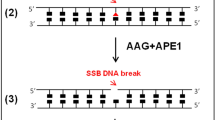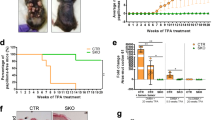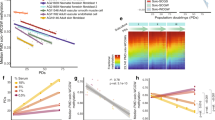Abstract
Methylating mutagens are thought to act by induction of direct miscoding, mainly through formation of O6-methylguanine (O6MeG) in DNA of, for example, T-even bacteriophage1, Escherichia coli2, and a cultured Chinese hamster cell line3. A positive correlation between this reaction in DNA of target tissues and subsequent induction of tumours has been found for rat kidney tumours4 and thymic lymphomas in mice5. These effects are thought to be counteracted by an enzymatic repair process, which removes O6-MeG from DNA (first found in E. coli6, then in liver of rats7 and mice5). The predominance of liver as the site of this action in vivo led to suggestions7 that this could account for the relative lack of susceptibility of liver tissue to methylating carcinogens, and also that the enzyme involved might be inducible8. Evidence for the latter has been claimed for rat liver9, but is most convincing in E. coli10 where inhibition of this enzymatic action is achieved by treating cells with chloram-phenicol before methylation11, thus specifically inhibiting protein synthesis. As there is very limited removal of O6-MeG from methylated cellular DNA, compared with that of 3-methyladenine (3-MeA, a suggested DNA template-inactivating base), it is thought that the former reaction is mediated by a protein which is consumed by the reaction12. There have been reports13,14 that human cells also can remove O6-MeG, but the data did not clarify the time- and dose-dependencies of the process. We report here more effective removal at lower extents of methylation, which suggests a nonlinear dose response to methylating mutagens and carcinogens for human cells. There were no significant deficiencies in methylpurine removal from DNA of patients with ataxia telangectasia (AT) or xeroderma pigmentosum (XP).
This is a preview of subscription content, access via your institution
Access options
Subscribe to this journal
Receive 51 print issues and online access
$199.00 per year
only $3.90 per issue
Buy this article
- Purchase on Springer Link
- Instant access to full article PDF
Prices may be subject to local taxes which are calculated during checkout
Similar content being viewed by others
References
Loveless, A. Nature 223, 206–207 (1969).
Jeggo, P. J. Bact. 139, 783–791 (1979).
Newbold, R. F., Warren, W., Medcalf, A. S. C. & Amos, J. Nature 283, 596–599 (1980).
Nicoll, J. W., Swann, P. F. & Pegg, A. E. Nature 254, 261–262 (1975).
Frei, J. V., Swenson, D. H., Warren, W. & Lawley, P. D. Biochem. J. 174, 1031–1044 (1978).
Lawley, P. D. & Orr, D. J. Chemico-biol. Interactions 2, 154–157 (1970).
O'Connor, P. J., Capps, M. J. & Craig, A. W. Br. J. Cancer 27, 153–166 (1973).
Lawley, P. D. IARC Sci. Publ 12, 181–210 (1976).
Montesano, R., Brésil, H. & Margison, G. P. Cancer Res. 39, 1798–1802 (1979).
Samson, L. & Cairns, J. Nature 267, 281–282 (1976).
Warren, W. & Lawley, P. D. Carcinogenesis 1, 67–78 (1980).
Robins, P. & Cairns, J. Nature 280, 74–76 (1976).
Goth-Goldstein, R. Nature 267, 81–82 (1977).
Akamirano-Dimas, M., Sklar, R. & Strauss, B. Mutat. Res. 60, 197–206 (1979).
Weichselbaum, R. R., Nove, J. & Little, J. B. Nature 271, 261–262 (1978).
Karran, P., Lindahl, T. & Griffin, B. Nature 280, 76–77 (1979).
Lawley, P. D. & Warren, W. Chemico-biol Interactions 12, 211–220 (1976).
Lehninger, A. L. Biochemistry 2nd edn, 832–833 (Worth, New York, 1976).
Preussmann, R. in Primary Liver Tumours (eds Remmer, H., Bolt, H. M., Bannasch, P. & Popper, H.) 11–29 (MTP Press Ltd., Lancaster, 1978).
Kakunaga, T. Proc. natn. Acad. Sci. U.S.A. 75, 1334–1338 (1978).
Arai, M. et al. Gann 70, 549–558 (1979).
Maher, V. M., Dorney, D. J. Mendrala, A. L. Konze-Thomas, B. & McCormick, J. J. Mutat. Res. 62, 311–323 (1979).
Penman, B. W., Hoppe, H. IV & Thilly, W. G. J. natn. Cancer Inst. 63, 903–907 (1979).
Cox, R. & Masson, W. K. Int. J. Radiat. Biol. 26, 193–196 (1974).
Kirby, K. S. Biochem. J. 66, 495–504 (1957).
Author information
Authors and Affiliations
Rights and permissions
About this article
Cite this article
Medcalf, A., Lawley, P. Time course of O6-methylguanine removal from DNA of N-methyl-N-nitrosourea-treatedhuman fibroblasts. Nature 289, 796–798 (1981). https://doi.org/10.1038/289796a0
Received:
Accepted:
Issue Date:
DOI: https://doi.org/10.1038/289796a0
Comments
By submitting a comment you agree to abide by our Terms and Community Guidelines. If you find something abusive or that does not comply with our terms or guidelines please flag it as inappropriate.



